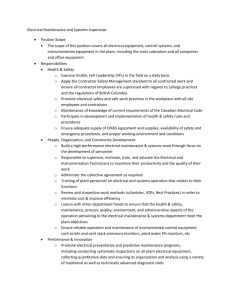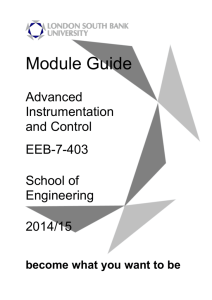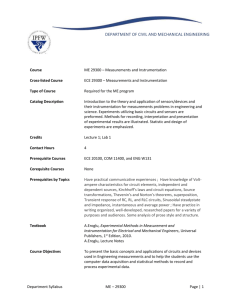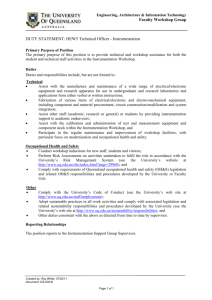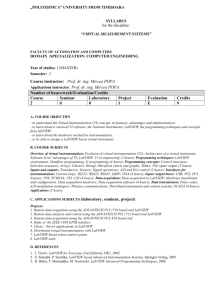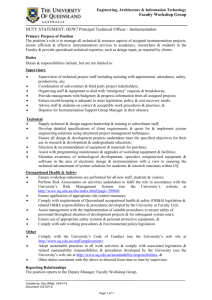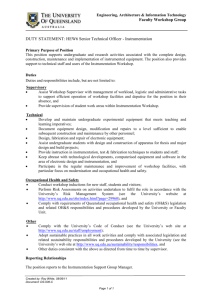EEB_7_404-AdvInstrumentation&Control MD_V2
advertisement
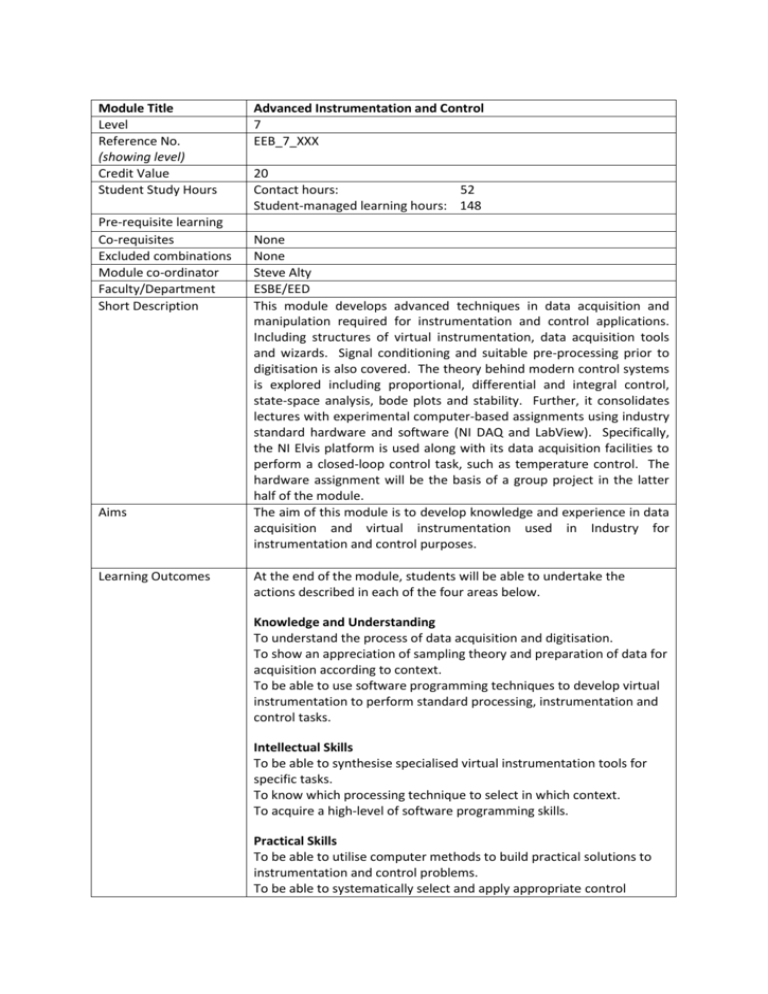
Module Title Level Reference No. (showing level) Credit Value Student Study Hours Pre-requisite learning Co-requisites Excluded combinations Module co-ordinator Faculty/Department Short Description Aims Learning Outcomes Advanced Instrumentation and Control 7 EEB_7_XXX 20 Contact hours: 52 Student-managed learning hours: 148 None None Steve Alty ESBE/EED This module develops advanced techniques in data acquisition and manipulation required for instrumentation and control applications. Including structures of virtual instrumentation, data acquisition tools and wizards. Signal conditioning and suitable pre-processing prior to digitisation is also covered. The theory behind modern control systems is explored including proportional, differential and integral control, state-space analysis, bode plots and stability. Further, it consolidates lectures with experimental computer-based assignments using industry standard hardware and software (NI DAQ and LabView). Specifically, the NI Elvis platform is used along with its data acquisition facilities to perform a closed-loop control task, such as temperature control. The hardware assignment will be the basis of a group project in the latter half of the module. The aim of this module is to develop knowledge and experience in data acquisition and virtual instrumentation used in Industry for instrumentation and control purposes. At the end of the module, students will be able to undertake the actions described in each of the four areas below. Knowledge and Understanding To understand the process of data acquisition and digitisation. To show an appreciation of sampling theory and preparation of data for acquisition according to context. To be able to use software programming techniques to develop virtual instrumentation to perform standard processing, instrumentation and control tasks. Intellectual Skills To be able to synthesise specialised virtual instrumentation tools for specific tasks. To know which processing technique to select in which context. To acquire a high-level of software programming skills. Practical Skills To be able to utilise computer methods to build practical solutions to instrumentation and control problems. To be able to systematically select and apply appropriate control algorithms using NI LabView. To evaluate the performance of a given system and its behaviour. Employability Teaching and learning pattern Indicative content Assessment Elements & weightings Indicative Sources (Reading lists) Transferable Skills To effectively communicate and critically evaluate observed results in a technical format. To competently maintain a logbook. To analyse data using complex mathematical techniques. This module will provide students with a sound knowledge of virtual instrumentation and control techniques commonly used in industry. National Instruments LabView environment is widely used throughout the electrical and electronic engineering industry and experience will enable students to gain employment therein. 26 hours of Lectures 26 hours of Labs Lectures Data flow programming in LabView Structures of Virtual Instrumentation Data structures Sub-VIs Data acquisition tools and DAQ wizards Sampling Theorem and Anti-Aliasing Filtering Closed loop control systems Computer Labs NI Elvis platform Signal pre-processing Data acquisition VI creation Group project: PID temperature control (6-weeks) Exam (2 hrs) 50% (Testing Knowledge, Understanding and Intellectual Skills) Course work and formal assignments 50% (Testing Practical Skills and Transferable Skills) 1 hour phase test in Week 8 to test knowledge acquired during previous weeks’ lecture material (worth 10%) Labs; students hand in a logbook, a formal report and software assignment in week 13 (worth 40%). The assignment will test students’ ability to develop a NI LabView virtual instrument to perform data acquisition and solve a control theory problem. All courseworks are summative, formal reports will contain formative feedback. Formal reports should be no more than 3000 words. Core reading: 1. King, R., Introduction to Data Acquisition with LabView, McGrawHill, 2nd Edition, 2012. 2. Dorf and Bishop, Modern Control Systems, Pearson, 12th Edition, 2012 Background reading: 3. Essick, J., Hands-On Introduction to LabVIEW for Scientists and Engineers, OUP, 2nd Edition, 2012





